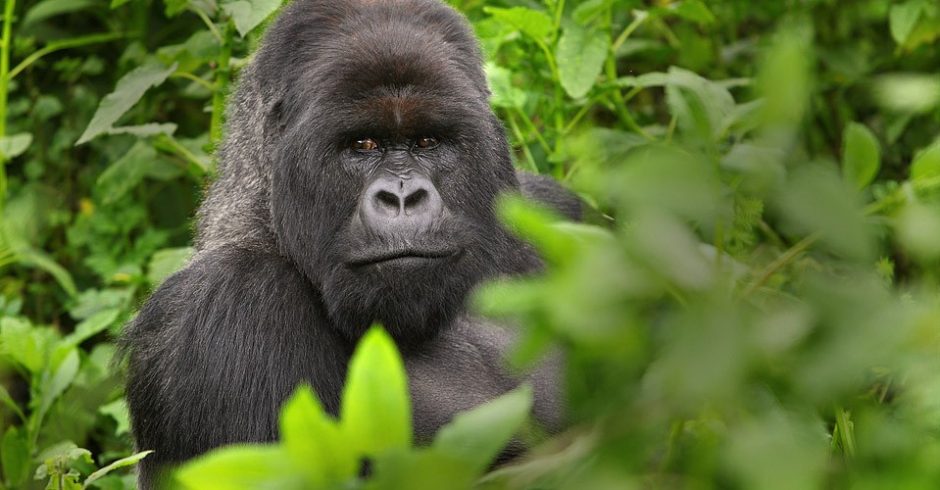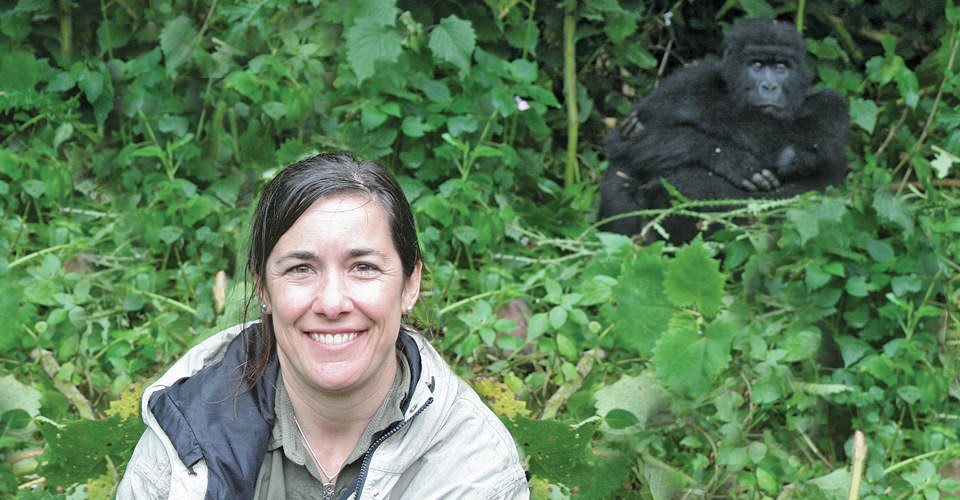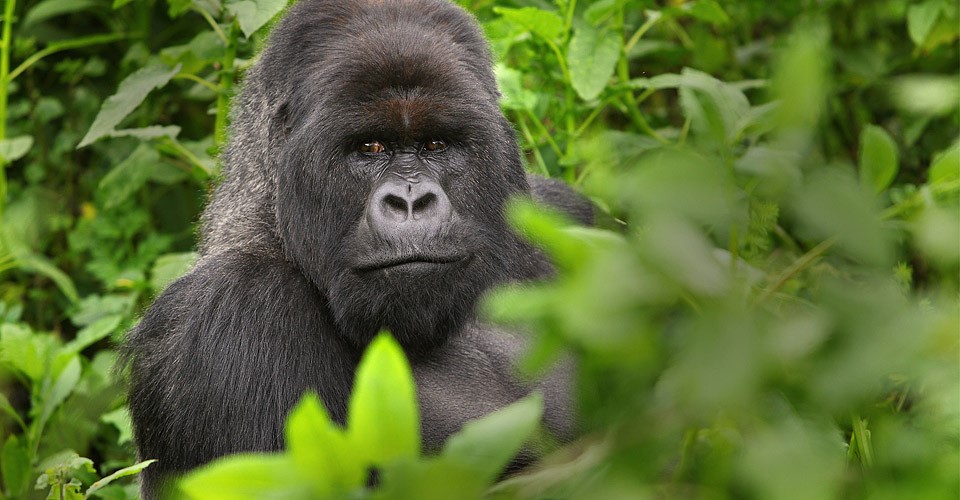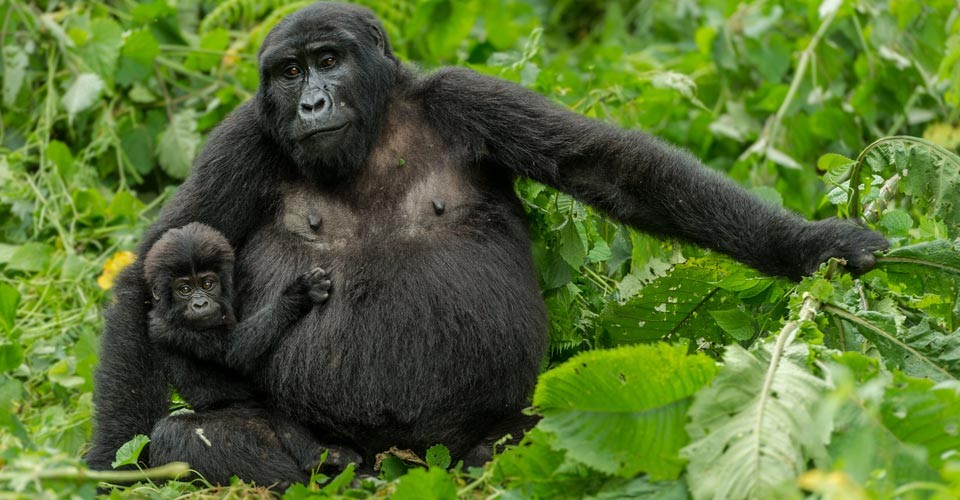
What’s in your Camera Bag? Gorilla Trekking Safari
It’s sure to be a top highlight of your photographic career and one of the most memorable nature safaris you will ever do – a Gorilla Photographic Safari. However, it’s not without its challenges…from the terrain, to the impenetrable nature of the jungle, to the low light photo conditions. Follow these tips on what to bring so that you are prepared for the ultimate wildlife photo safari.
Please note, photographic styles vary, as do conditions on the ground. While this is meant to be a guide for choosing your camera gear, you should consider your own photographic interests first and foremost.
Wide Angle Zoom
No list of camera gear would be complete without mentioning this handy, versatile, and essential lens. How much time it spends on your camera will depend on your own photographic style and preferences (i.e., more landscape and culture, or solely interested in big wildlife photos), but one thing’s for sure is that it will be on your camera at some point of your trip. It’s your “walking around” lens, and you’re looking for something in the 18-55mm, 24-70mm, or 24-105mm range for DSLRs or a 7-20mm, or 12-40mm on a mirrorless setup.

Zoom Telephoto
A safari to view and photograph gorillas in the wild is yet another place where you have to plan on being versatile. This category is likely to be your most-used. While the gorillas are going to be close, you’ll want the flexibility to fill the frame and also get some landscape in your photo to really tell the story and document your rare encounter.
Here’s where things get interesting. The conditions for photographing gorillas do present certain challenges, and having a lens capable of a very wide aperture is going to be a very helpful tool. A) you’re going to have less than ideal light, so you’ll need the big aperture (e.g., f/2.8, if possible) to shoot with a fast enough shutter speed in dim rain forest conditions, and B) there’s a good bit of vegetation that you’ll likely want to intentionally blur with a shallow depth of field.
Thus, one of my top picks for lenses on this trip is a 70-200mm f/2.8. The zoom telephoto range is good enough to be your go-to while with the gorillas and the f/2.8 will be a game changer for your photography. Take a look at the below photo to see how the photographer used a shallow depth of field to isolate the subject and blur the errant leaves and foliage, which are just a distraction if they were to be in focus.

Do I bring a Super Telephoto?
Normally I would categorize a super telephoto as something 400mm or 500mm and above. However, in this context, because the trusty 70-200mm is such a great zoom telephoto, I’ll lump your 70-300mm and 100-400mm lenses in with this current section.
When photographing wildlife, even big wildlife like gorillas, there is still almost no limit to how much zoom you could use. Why wouldn’t you want to get an amazing fill-the-frame shot of a male silverback if you could?
Yes, these are great photo ops and are dreamy when you get them perfectly.

However, you don’t necessarily need a big telephoto lens to capture this. Sure, if you want a fill-the-frame shot of every gorilla you see throughout the entire trip, maybe you’d need a 400mm or 500mm, but you’ll certainly have the opportunity to get this shot with a 300mm at some point during your visits with the gorilla troops.
If you do plan on bringing something greater than a 200mm lens, it’s advisable to leave the big fixed 400mm at home and instead bring a zoom telephoto to give you more flexibility…something like a 70-300mm, or 100-400mm is ideal.
One key consideration with this topic, though, is what else you may be doing on your adventure besides trekking to see gorillas. For instance, Natural Habitat Adventures incorporates a visit to Queen Elizabeth National Park as part of their gorilla trekking safari. For this, a more traditional safari lens, like a 100-400mm or 80-400mm is essential.
X-factor Lenses
As you may already know about me, I’m always trying to get photographs that are different than the norm. To build a portfolio that gets recognized, you have to have some of the quintessential shots that are already all over photo books and online, but you should also think outside the box. Here’s where the creative lenses come in.
Generally my go-to x-factor lenses are either an ultra-wide angle (for a near fish-eye look) or a “nifty fifty” lens, which is essentially just a 50mm f/1.4 or f/1.8 lens, allowing for an extremely shallow depth of field.
Whether you choose one of these, or opt for something else like a macro lens, or even a dedicated fish-eye is going to depend on your own photographic style. However, I have to say that I rarely leave my ultra-wide angle at home, as it’s so versatile in tight situations (inside vehicles or camps for dramatic travel shots).

Accessories and other gear
For this tropical environment, it’s rather important to have rain protection for your camera. A storm jacket or other type of rain cover/dry bag is helpful. And extra batteries and memory cards are a must.
A tripod would be helpful in the low light environment of gorilla habitat, but they are extremely cumbersome and could draw the attention of the wildlife you’re observing in a bad way (causing unnatural behavior if you’re shuffling around the brush with the tripod legs). In addition, being locked into a tripod means that you won’t be versatile to whip around and photograph the young gorilla approaching from behind, if you’re centered on the larger more obvious gorilla in the other direction.
One final consideration is whether you’d like to bring a second camera body. To be frank, a second body is always a good idea in the sense that you can have a different lens on each without having to waste time changing lenses. This translates into being able to capture many more photos – a good thing! However, you must always consider the weight and difficulty in dealing with two cameras hanging around your neck, hiking with them in your pack (most gorilla treks will be done with porters, as the hiking can be somewhat challenging), etc. It’s not critical, but certainly worth mentioning.
If you do have a Photographic Gorilla trekking safari planned, good for you – it’s going to be the time of your life! If not, make sure it’s on your short list and let me know if you need any advice on the best trip for you.
All the best,
Court
16 Comments

James M.
February 24, 2019 at 4:22 pm

Court Whelan, Ph.D.
March 6, 2019 at 7:00 pm

Laurie U
March 20, 2019 at 7:21 am

Court Whelan, Ph.D.
April 30, 2019 at 11:56 am

Christy
October 8, 2019 at 12:41 pm

Court Whelan, Ph.D.
October 9, 2019 at 11:55 am

Andy W
March 5, 2020 at 9:04 am

Court Whelan, Ph.D.
March 5, 2020 at 6:12 pm

Kevin L.
June 29, 2021 at 2:06 pm

Court Whelan, Ph.D.
June 30, 2021 at 10:54 am

Kevin L
June 30, 2021 at 11:51 am

Court Whelan, Ph.D.
July 1, 2021 at 9:45 am

Kevin L
July 1, 2021 at 5:41 pm

Court Whelan, Ph.D.
August 6, 2021 at 12:37 pm

Phillip S
March 22, 2022 at 2:24 pm

Court Whelan, Ph.D.
March 29, 2022 at 11:53 am
I’m wondering what your thoughts are on the mid-range cameras with integrated lenses for this application. For example, the Nikon P900 or P1000, or the Canon SX60-HS or G3-X. Since I don’t already have a DSLR camera and lenses, what would I be giving up by going with one of these much more economically priced options?
Hey James, great question! These are all really good cameras and I’ve used several of them, and recommend them often. At the end of the day, they’re going to work, and work well. However, the biggest limitation they have is their sensor size, which is quite a bit smaller than mirrorless or DSLR cameras. And what this translates to is ability to shoot in lower light, and overall resolution. You would indeed notice a difference between, say, a decent DSLR and the Canon SX60 when comparing photos side by side. However, one thing that these all offer that a DSLR or mirrorless doesn’t is the ability to NOT have to change lenses. And what I’ve found over the years is that you will literally get more shots when you don’t have to change lenses. Thus, while each individual shot may be slightly lesser in quality on one of these systems, you will literally get shots you likely wouldn’t have otherwise gotten because of the ease of use and ability to shoot wide angle one second, and ultra telephoto the next.
Hopefully this gets you somewhat of an idea of the pros and cons. At the end of the day, a DSLR or mirrorless is going to get you technically better photos, but you must ask what are you willing to sacrifice because of it–ease of use? size and weight of the system? hefty price tag? I think you see where I’m coming from :). Cheers!
I have a similar question. We are going to Uganda on chimp and gorilla treks but also headed to Queen Elizabeth and Murchison Falls. I recently dropped my DSLR so we are in the market for a new camera before our safari. The local camera store recommended the Nikon P1000 because of its zoom, but I am leaning toward a new Nikon DSLR and the 18-400mm f/3.5-5.6 lens. We are not expert photographers, but so some bird photograph in Florida. Thanks for your article and advice!
I’m always a fan of DSLRs, and an 18-400 is going to give you a TON of flexibility! the P1000 is maybe even more versatile, having more zoom, but the quality is going to degrade a little as you go beyond the 400mm or 600mm equivalent. Thus, I think it’s a great call to do the 18-400 plus Nikon DSLR
I’d love to know what camera bag you suggest – backpack or easy to access side bag.?
Hey Christy, I personally am in favor of a backpack. I find side bags throw you off your balance, whether in an airport transiting or on a trail. However, depending on exactly how much camera gear you have, don’t be afraid to just buy some simple lens protectors and throw them in your existing, favorite day pack. I often do this when I’m just bringing my camera, charger, and two lenses. I’ve found that a lot of the fancy camera bags from proper bag manufacturers are just overbuilt and less ideal for actual time on the trail.
Good luck!
Hi Court: I am very happy with the equipment I have and what I plan on bringing when I join this trip in September. The one that I really facilitate with is my Nikor 5.6 200-500. It’s a beast of a lens and will be great for the non-gorilla experiences. My question is whether it is safe to leave it with my luggage when we go on the treks and other areas when I am not using it and do not want to bring it with me. It’s a very heavy lens too, so I am trying to take that into consideration; the weight of the lens and how much I will use it. I will be taking with me two bodies, a D500 and a D850. The walk around lens on the D500 will be the f/2.8 16-80. The walk around lens for the 850 is the f2.8 24-70. I will also have two other lenses, the Nikkor f/2.8 14-24 and a zoom Nikkor f/2.8 70-200. It’s a lot of gear, so adding a really heavy lens raises concerns for me. I thought I would get your thoughts. I know I would use the big zoom and it would be a big help, but I’m concerned when I am not using it will it get in the way?
Hi Andy, great question here! First of all, before even commenting on the safety of the lens in your hotel room (which it would indeed be fine), I’ll say that I would actually bring it with me in your case. While a 500mm seems overkill, you have the chance of getting some AMAZING full frame photos. Weight really isn’t an issue, as you have access to porters. If you’re on a Nat Hab trip, we provide one for you, and if you really feel like it you can get a second one for $25 a day. While one porter would carry all of that just fine, if you’re concerned, or they seem burdened, for an extra $25 you might get a few extra photos of a lifetime. And plus, these porters are THRILLED to get the work, so I often hire a couple extra porters just to get them jobs for the day. This all being said, security isn’t really a concern in the lodges. I can’t guarantee that, as crazy things happen, but the track record in the lodges I’ve been in are perfect, and upon meeting the folks there, you can understand why…some of the best people on earth. To summarize, you definitely want the 70-200, and you want one of the walking around lenses, but the 200-500 could be a game changer. I think you’ll use the 70-200 most of the time, but I guarantee you’ll get some amazing shots with the bigger lens and be happy to brought it along. One strategy would be to do all this on your first trek, and then see if it actually pays off. If you say, nah, not worth the bother, than leave it back the next day. But, I have a sneaking suspicion that you’ll be happy you toted it along.
Hope this helps!
Hi Court. I am heading to Uganda in 1 1/2 weeks. I will have other gear with me for safaris in Kenya after the gorilla treks, but for gorillas I plan to take two Sony A1 cameras, and three lenses: 24-70 f/2.8, 70-200 f/2.8, and 138 f/1.8. I will be doing three days of gorilla treks.
Question 1: Should I have a porter carry my 40L bag with this equipment, or should I bring a light weight backpack in my luggage, and only carry this above equipment on the trek in the lighter bag? Any suggestions for a lighter weight bag?
Question 2: I will also have a 400 f/2.8 lens for the safari (and teleconverters). The 400mm lens weighs 6.4 lbs., a bit more than the 200-500 you suggested to someone else that they bring. What are your thoughts about taking that along as well for at least one of the three days of trekking?
Hi Kevin, you’ve got some dreamy options here! I like them all :). Indeed happy to help.
So for your first question, I would indeed recommend having a porter (or an extra porter) carry your gear. Porters are an instrumental part of the system, and they are employed almost entirely by folks trekking, so for the $25 a day, it’s a lifeline of work for them. And for the $25 for a porter (or an extra porter, if going with Nat Hab, as we already provide one), it’s a reasonable way to be sure to not leave anything back that you may regret. The alternative, if you are looking for a lighter bag, is to perhaps get one of the SeaLine waterproof backpacks (I like the Big Fork 30 liter, personally) and to store all of your gear in there. The bag weighs very, very little, but is 100% waterproof and actually fairly comfy for a day hike. But again, I’d go with the porter option.
For #2, I would at least consider bringing it one day. To me, I would probably leave it back the first day, so that you can get your bearings and see if you really need it based on your photographic style and goals. Then, if you wish you would have had it, you have two more days you can bring it along. And again, for an additional porter for $25, it’s a great way to employ and to bring all your gear :).
I hope this helps, and do let me know if I can answer any other questions! Your main lenses you were talking about are indeed ideal. I’ve been seeing some AMAZING shots with the 135 f/1.8 with chimps and gorillas. But the 70-200 is such a great addition, too. All three lenses will get a lot of use, and who knows, you may really like the 400 f/2.8, too!
Thanks so much for the quick response! I will follow your suggestion for lenses on the first day and see if the 400 looks like a good option to bring the second/third day.
I was planning to hire a porter for the trek, so I should be covered there. Do you find it worthwhile keeping a camera on you while trekking, or best to keep the equipment in the backpack and just get it from the porter when needed?
Also, I just took a look at the SealLine Bigfork 30L Dry Daypack. Since there is no padding/compartments in the bag, How do you protect the camera equipment when being carried in the pack? I wasn’t planning to bring the padded cases that came with the lenses since the cases are too bulky for my luggage.
Hey Kevin, yes I’d recommend keeping one camera out with your “walking around lens” for general travel shots, landscape shots, trekking shots, etc. I wouldn’t expect too much wildlife en route to the gorillas, so having a big lens is less ideal than a small landscape/travel lens. As far as the sealine, yep, it’s just a dry bag, so if you do go that route, and don’t have cases for your lenses, I’d just wrap everything in t-shirts or a fleece for protection. That being said, I’m also equally likely to just bring my main backpack/camera bag and have a proper rain cover on it for ultimate protection.
Thanks again for your advice. I really appreciate it!
most welcome!
Hi Court, huge fan of your work! I have a Sony A7RIV and a 200-600mm f/5.6-6.3 lens. It seems like overkill for doing a gorilla trek, but I’m not sure if I want to drop a couple grand on a 70-200 lens. Would you say that I have a decent setup or really that that 70-200 with that f/2.8 aperture?
Hi Phillip, great question! I think you will really enjoy using your 200-600, actually. However, be ready to primarily use a wide angle lens in conjunction, as 200 may be a bit too much telephoto for many photos. Trust me, it will be GREAT to have that much telephoto to really zoom in on the faces and capture emotion and their eyes, but I’d say many shots will be in the 50-300mm range, so just make sure you have another lens that is in and around that range (like a 24-105 or similar). Hope this helps!